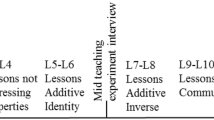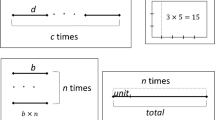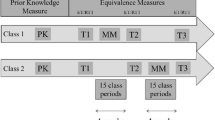Abstract
We have characterized what we callrelational thinking to include looking at expressions and equations in their entirety rather than as procedures to be carried out step by step. For the last 8 years, we have been studying how to provide opportunities for students to engage in relational thinking in elementary classrooms and how to use relational thinking to learn arithmetic. In this article, we present interviews with two third-grade students from classrooms that foster the use of relational thinking. In both cases, we focus on the distributive property. The first example illustrates how a teacher scaffolds a sequence of number sentences to help a student begin to relate multiplication number facts using the distributive property. The second example shows another student who is already using the distributive property and the extent of his knowledge.
Kurzreferat
Wir gehen in dem Beitrag von einer Charakterisierung von relationalen Denken aus und beschreiben, was es bedeutet, die Analyse von Termen und Gleichungen mehr ganzheitlich zu betrachten als als schrittweise auszuführende Prozeduren. Während der letzten 8 Jahre haben wir untersucht, wie Lernenden in Grundschulklassen Möglichkeiten zum Betreiben und Anwenden von relationalen Denken beim Lernen von Arithmetik angeboten werden können. In diesem Beitrag stellen wir Interviews mit zwei Schülern aus dritten Jahrgangsklassen vor, in denen die Anwendung von relationalen Denken gezielt gefördert wird. In beiden Fällen kommt es uns besonders auf die distributive Eigenschaft der Multiplikation an. Das erste Beispiel zeigt deutlich, wie eine Lehrperson eine Folge von Zahlensätzen aufbaut, um einem Schüler dabei zu helfen, zu beginnen, multiplikative Zahleneigenschaften in Beziehung zu setzen unter Verwendung der Distributionseigenschaft. Das zweite Beispiel zeigt einen weiteren Schüler, der bereits die Distributionseigenschaften anwendet sowie seinen Wissensstand.
Similar content being viewed by others
References
Behr, M., Erlwanger, S., & Nichols, E. (1980): How children view the equal sign.—In: Mathematics Teaching Vol. 92, p. 13–15
Bransford, J. D., Brown, A. L., & Cocking, R. R. (Eds.) (1999): How people learn: Brain, mind, experience, and school.—Washington, DC: National Academy Press
Carpenter, T.P., Franke, M.L., & Levi, L. (2003): Thinking mathematically: Integrating arithmetic and algebra in the elementary school.—Portsmouth, NH: Heinemann
Carpenter, T. P., & Lehrer, R. (1999): Teaching and learning mathematics with understanding.—In: E. Fennema & T. A. Romberg (Eds.), Mathematics classrooms that promote understanding. Mahwah, NJ: Erlbaum, p. 19–32
Davis, R. B. (1964): Discovery in mathematics: A text for teachers.—Palo Alto, CA: Addison-Wesley
Falkner, K. P., Levi, L., & Carpenter, T. P. (1999): Children's understanding of equality: A foundation for algebra.—In: Teaching Children Mathematics Vol. 6, p. 231–236
Greeno, J. G., Colliins, A. M., & Resnick, L. (1996): Cognition and learning.—In: D. C. Berliner & R. C. Calfee (Eds.), Handbook of educational psychology. New York: Macmillan, p. 15–46.
Hiebert, J., & Carpenter, T. P. (1992): Learning mathematics with understanding. In: D. Grouws (Ed.), Handbook of research on mathematics teaching and learning. New York: Macmillan, p. 65–97
Jacobs, V., Franke, M. L., Carpenter, T. P., & Levi, L. (2005). Paper presented at the annual meeting of the American Educational Research Association, Toronto, April 11–15, 2005
Kieran, C. (1992): The learning and teaching of school algebra. —In: D. Grouws (Ed.), Handbook of research on mathematics teaching and learning. New York: Macmillan, p. 390–419
Kilpatrick, J., Swafford, J., & Findell, B. (Eds.). (2001): Adding it up.—In:Washington, DC: National Academy Press
Koehler, J. (2002). Algebraic reasoning in the elementary grades: Developing an understanding of the equal sign as a relational symbol.—University of Wisconsin—Madison, Master's paper
Koehler, J. (2004). Learning to think relationally and using relational thinking to learn.—University of Wisconsin— Madison, Doctoral Diss.
Matz, M. (1982): Towards a process model for school algebra errors.—In: D. Sleeman & J. S. Brown (Eds.), Intelligent tutoring systems. New York: Academic Press, p. 25–50
National Council of Teachers of Mathematics. (1998): The nature and role of algebra in the K-14 curriculum.— Washington, DC: National Academy Press
National Council of teachers of Mathematics. (2000): Principles and standards for school mathematics.—Reston, VA: Author
Saenz-Ludlow, A., & Walgamuth, C. (1998): Third graders' interpretations of equality and the equal symbol.—In: Educational Studies in Mathematics Vol. 35, p. 153–187
Author information
Authors and Affiliations
Additional information
The research reported in this article was supported in part by a grant from the National Science Foundation (ESI9911679) and a grant from the Department of Education Office of Educational Research and Improvement to the National Center for Improving Student Learning and Achievement in Mathematics and Science (R305A60007-98). The opinions expressed in this paper do not necessarily reflect the position, policy, or endorsement of the National Science Foundation, the Department of Education, OERI, or the National Center.




